Our first blog post of 2020 and no sooner did we ring in the new decade, we are already almost halfway through January. This month, with everyone receiving lots of packaging along with their presents and many a box of Ferrero Rochers consumed (hands up, surely we aren't the only guilty party(?!) January is a great time to upcycle.
In the days when there are more and more calls to reduce the number of things we buy, we strive to buy less and less each week BUT what can we do to save items from landfill and reuse? For us, upcycling is linked to slowing down - slowing down before we automatically throw something away, slowing down to consider whether we really NEED that new item or whether we can make something similar with what we have and also taking the time to upcycle something and devote the time it deserves. If we do a half-hearted job, chances are we won't be happy with it and we will end up buying new anyway.
So you're at a point where you have a project to upcycle but have no idea where to start? Well first off we should mention that we are always here and always happy to help so if you have a question about a surface or project you're not sure how to paint and you would like advice, drop us an email at toni@folkit.co
However, we have put together a little blog for you to help guide you to find some answers when it comes to saving those boxes and tins from landfill so take a look and see if the answer you're looking for is here:
1) Ferrero Rocher boxes - these help to make
wonderful wet palettes. If we want to save money, we've got to look at our supplies first. The first rules we teach students is a)
take care of your brushes and they will take care of you and b) save your paints. We often overestimate how much paint we need and don't use all of it in one sitting. Rather than throw it away, pop the lid on and come back to it another day.
Just make sure that you do change your greaseproof paper and refresh your sponge every 4-5 days to prevent mould.
2) Chocolate boxes and gift boxes
These are the perfect projects because they are often small and contain flat surfaces to paint on as you gain confidence learning to paint 3D objects (which if you are just moving from 2D surfaces can take a bit of getting used to). These items can be porous or may have a shiny surface. If this is the case, chalky finish paint is great because you do not need to prep the surface or add primer. If you do choose to use acrylic paint, we recommend adding Multi-Purpose Sealer to your paint to help it adhere to your project. You can find out more about how to use this wonderful medium
in this tutorial
3) Coffee tins, cans and tubs
We love saving our tins to decorate and use for storage around the office. Nut tins, coffee jars, you name it they're perfect for storage. Whether it is paintbrushes, pens and rulers or things that are just cluttering up the place but don't have a home, they are our go-to projects. Similarly,
chocolate tubs can help store lots of bulkier items in the home and kitchen.
We ask friends and family to save cans and tubs too so we can create a matching collection of storage in different heights and sizes to create a bit of a centrepiece - we might as well make a feature out of them. If you have no need for extra storage, why not use them as packaging for next Christmas? They are perfect for housing gift cards or money, sweets or handmade baked goods for a loved one...
and it gets rid of the need for unrecyclable wrapping paper.
Find out more about how to prep items like these tins and tubs
here.
Another idea (if you remembered to save the lids!) is to cut a slit into the lid and create your very own money box. Yes, money boxes are readily available but why not consume less, save that money and make your own? This is a fantastic project for kids too!
4) Glass
Once you have mastered the 3D surface, you can expand your skills and move on to glass. With so many beautiful bottles out there, you can create something really special. I once went to a wedding where the centrepieces were all painted bottles filled with fairy lights. They can make beautiful home decor but painting on glass requires a little work as you will
read here.
Old jam jars, glasses, vases are great projects but be aware, unless you use Glass paint, these will be for decorative purposes only and are not food or dishwasher safe.
...who says you need to wait for an empty bottle to paint? Why not co-ordinate the gift with the card and add a painted design on to the bottle before gifting instead of wrapping it?
We hope we have given you a few ideas to make the most of your Christmas packaging and given you the advice you need to complete up-cycling projects of your own. At Folk It! we passionately feel that with a little time and effort, painting is a great way to help us to reduce, re-use and up-cycle, it can help us save money, do our bit for the planet all the while giving us a creative escape that we crave.
Happy Folking x



